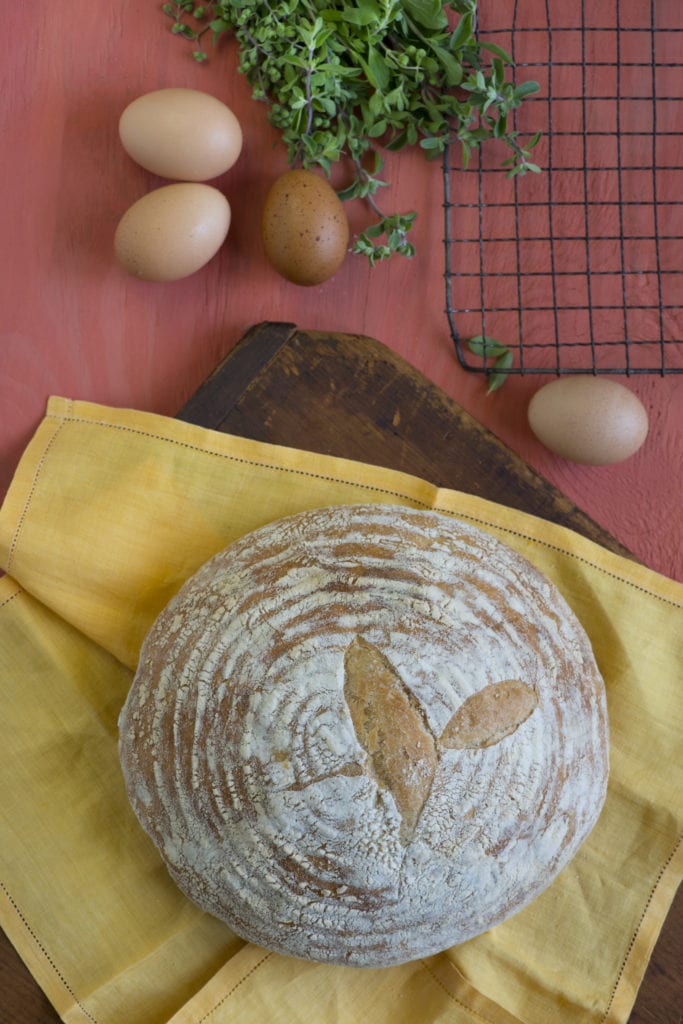
The best way for me to introduce Elisa Callow’s delightful book, “The Urban Forager: Culinary Exploring & Cooking on L.A.’s Eastside,” is to share my own experience with one of the recipes: the Twenty-One-Hour Boule.
Following the book’s suggestion, I headed to Pasadena flour mill Grist & Toll and was met with a friendly “Do you have questions?” While the man at the counter was offering advice (their whole-grain flour would make the dough rise twice as quickly as the recipe says), a woman came in to pick up an order.
That woman was Roxana Jullapat, head baker and co-owner of Friends & Family in east Hollywood. While her order was loaded into her truck, she advised me on which flour to use, suggested I double the salt and offered encouragement. “This bread will be so good you won’t even believe you baked this bread,” she told me.
It was just the sort of adventure Callow (pictured above), who lives in Altadena, imagined.
Founder of the Armory Center for the Arts in Pasadena, Callow is a consultant for nonprofit arts and education organizations, and began work on the cookbook partly as a resource for her adult children and partly to share her love of L.A. food. “Living in Los Angeles, unless you are a hermit, I don’t think it’s possible to ignore the unbelievable richness of this food culture,” she says.
Callow also wants home cooks to venture beyond the grocery store and discover small businesses like Grist & Toll, which is why each recipe offers shopping suggestions and the book itself ends with a rich resource guide detailing food destinations and the people behind them. “There are relationships that develop in going to small stores,” Callow says. “These people put their heart and soul in a commitment to creating beautiful food.” They’re also always ready to help and to teach.
One bite of my finished bread confirmed something else Callow told me about shopping small: “The quality of the food is so much greater.” The whole-grain heirloom flour milled by Grist & Toll made a huge difference in the bread’s taste and texture.
Callow says that the recipes in her book are purposely easy and this bread is no exception. “I call it the gateway drug to baking bread,” she says. Nonetheless, she offers a few tips:
Pay attention to the expiration date on your yeast package.
You want the dough to be wet, so add a little extra water if needed.
It’s easiest to do the first rise overnight, when the temperature is cooler and the process will be slower. But in the morning, it will be your eyes and touch, rather than a timer, that tell you when the dough is ready to shape.
No banneton? Don’t worry. Just flour a tea towel on both sides and use it to line any round bowl or basket.
Do not store your bread in a plastic bag. Store in a paper bag or wrapped in a tea towel.
Callow, a mother and grandmother, says you can definitely get the kids into the act. “There’s nothing more fun than folding that dough into the right shape,” she says. “And you can explain yeast to them and what’s happening.”
Twenty-One-Hour Boule From “The Urban Forager”
Based on a recipe by Jim Lahey of Sullivan Street Bakery.
Makes one 2-pound loaf
500 grams flour

¼ teaspoon active dry yeast
2 teaspoons salt
415 grams or more distilled water
In a large bowl, combine flour, yeast and salt; mix well. Add distilled water and stir until well blended. Dough should be wet and fairly sticky.
Cover bowl with plastic wrap and let rest in a warm spot for 18 hours. After this first rise, dough will be at least double in volume and small bubbles will have formed on the surface.
Using a flour-dusted dough scraper or spatula, scrape dough onto a clean, lightly floured work surface. Coat your hands with flour and gently pat dough with your palms to create a thick disk. Tuck under the circumference of the disk to create a round ball. Turn the disk over, round-side down. With both hands, gently reach under the dough and stretch the tucks in a bit more. Re-flour dough. Don’t fret over this step; each time you make this loaf, you’ll become more familiar with the bread and how to shape it.
Flour a banneton (wooden proofing-bowl), then place the ball of dough in the banneton, rough side up.
Dust dough with more flour and cover with a tea towel. Let dough rise for 2 hours, until it doesn’t readily spring back when poked with a finger. About 30 minutes before the end of this second rise, put a lidded 6- to 8-quart Dutch oven or heavy ovenproof pot into the oven and preheat oven to 475 degrees Fahrenheit.
When the oven has heated and the Dutch oven is hot, about 30 minutes, carefully remove pot from the oven.
Flip the banneton and hit it forcefully into the hot Dutch oven to release dough from the banneton. Remove the banneton while taking care to avoid the sides of the hot Dutch oven. Cover the pot, return it to the oven and bake for 30 minutes.
Uncover the Dutch oven and bake for 15 minutes or a bit more, until boule is browned and sounds hollow when tapped.
Remove from oven and immediately transfer boule to a rack to cool. Do not attempt to cut the boule until it’s cool, or you will get mush.
NOTE: The ingredients need to be weighed rather than measured by volume to ensure accuracy.
FOOD SOURCES: Cookbook or Grist & Toll. For bulk orders, Los Angeles Bread Bakers via The King’s Roost.



























